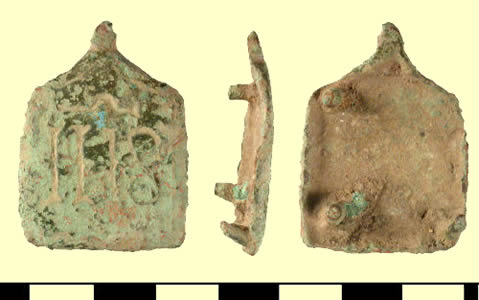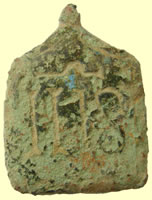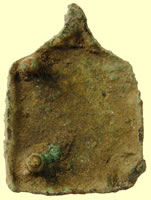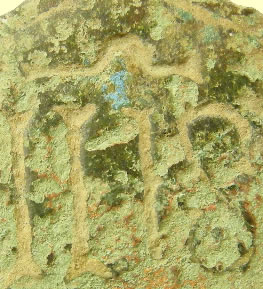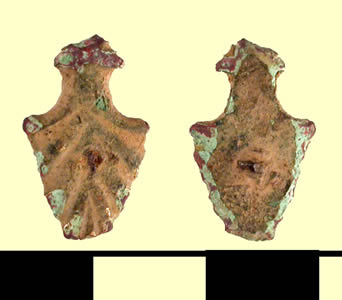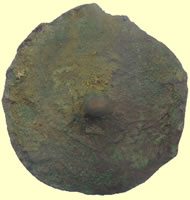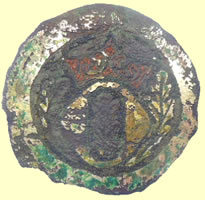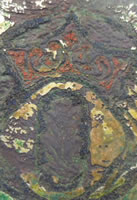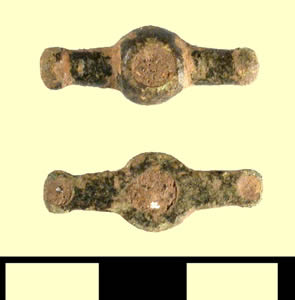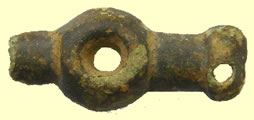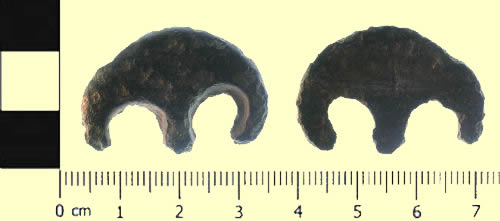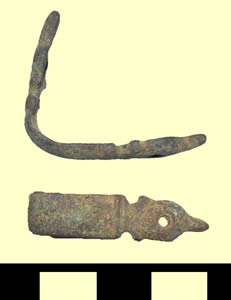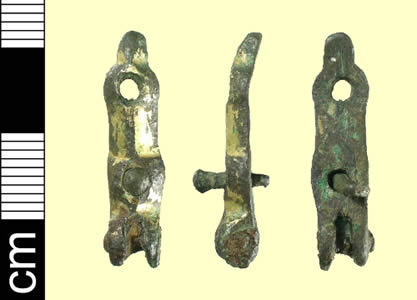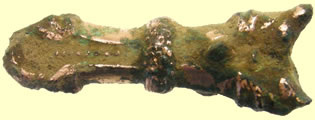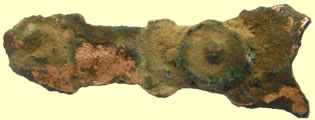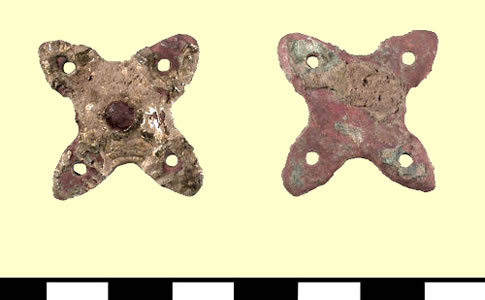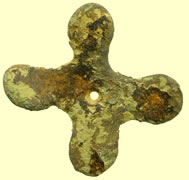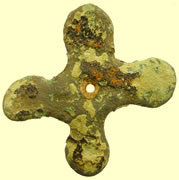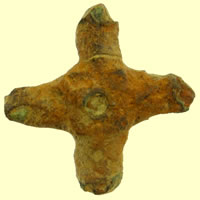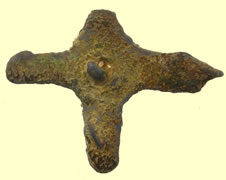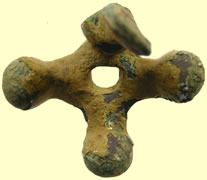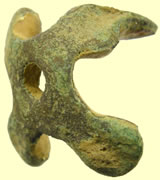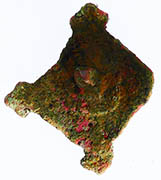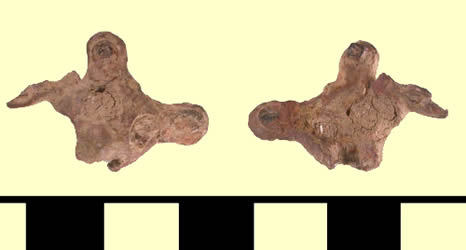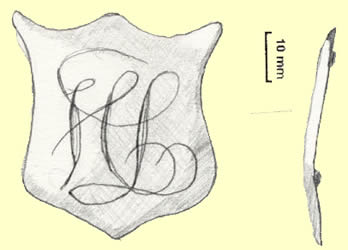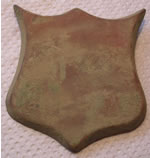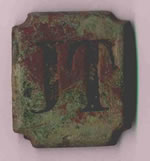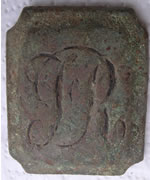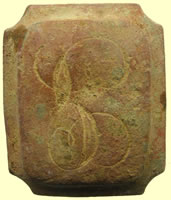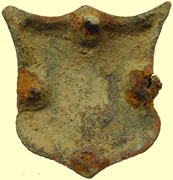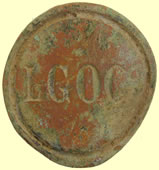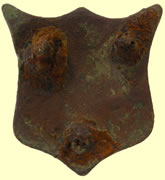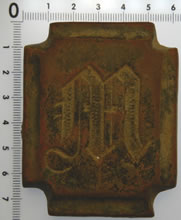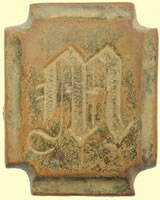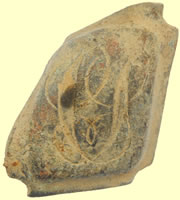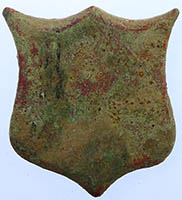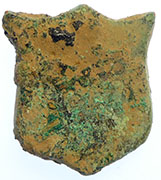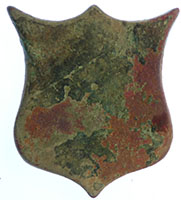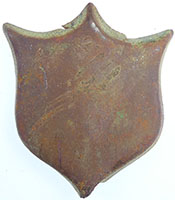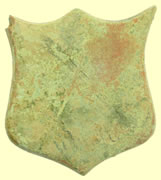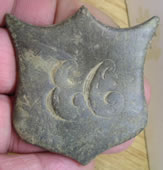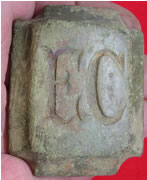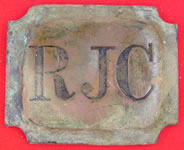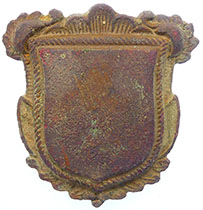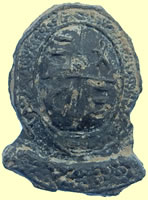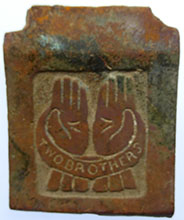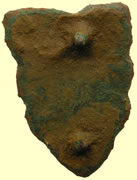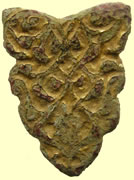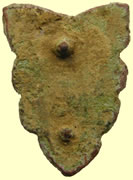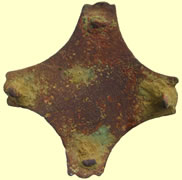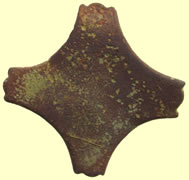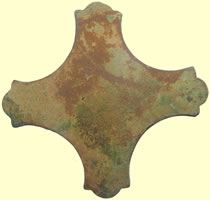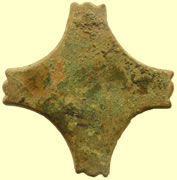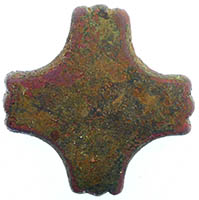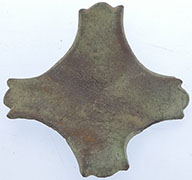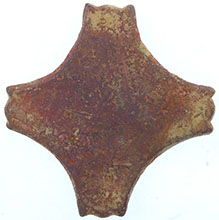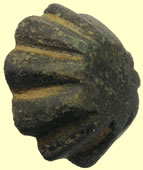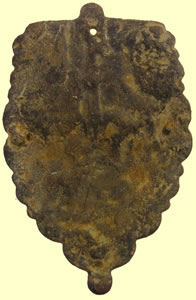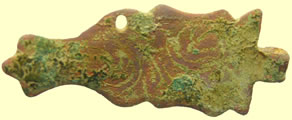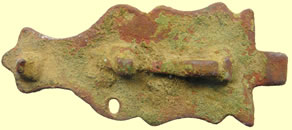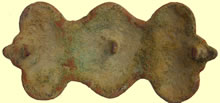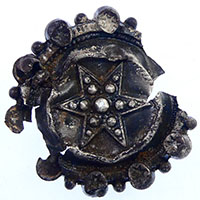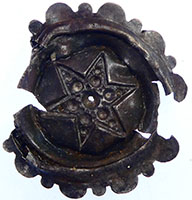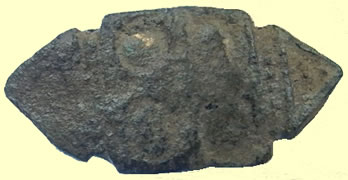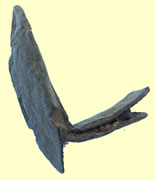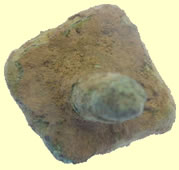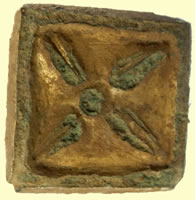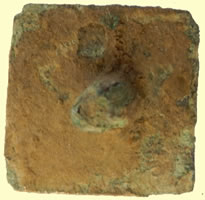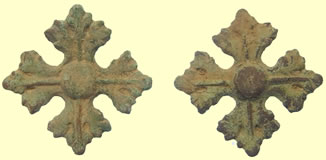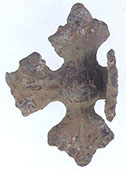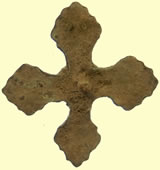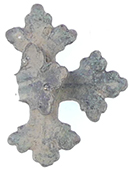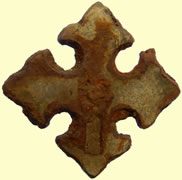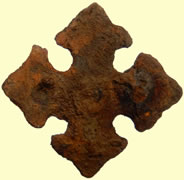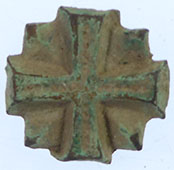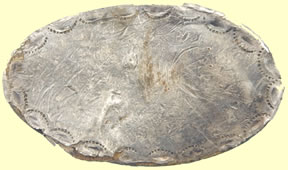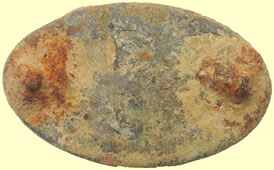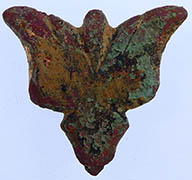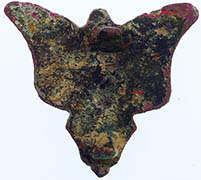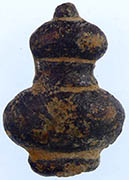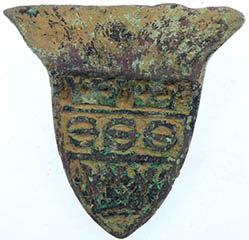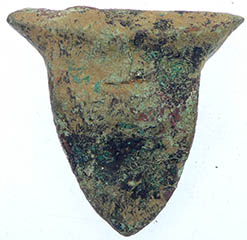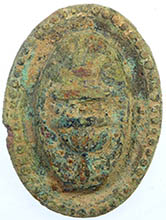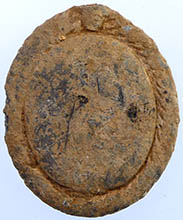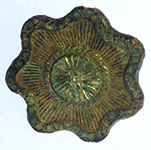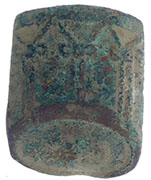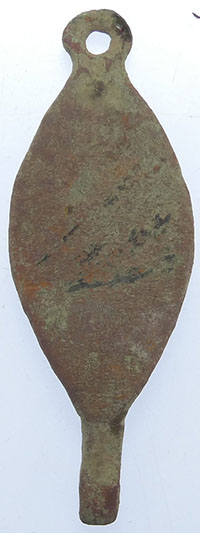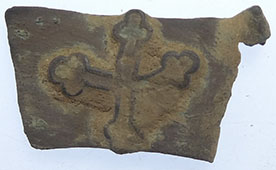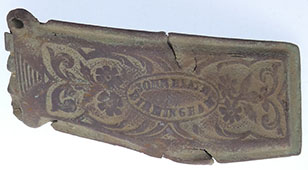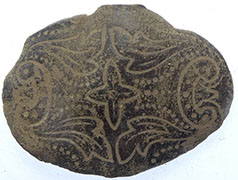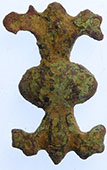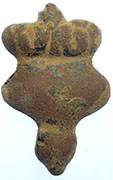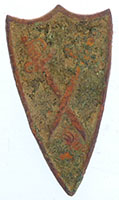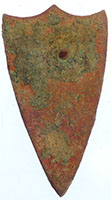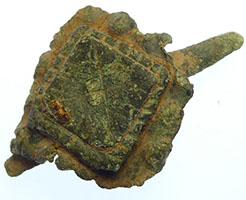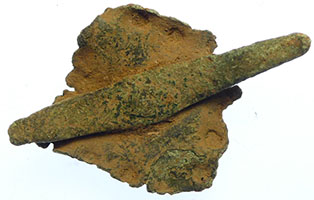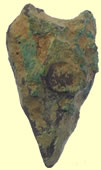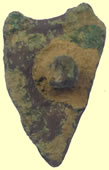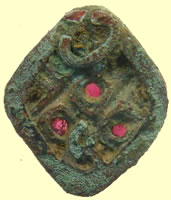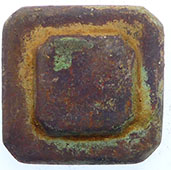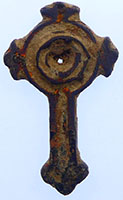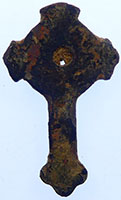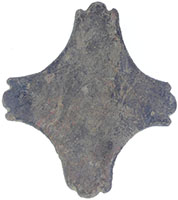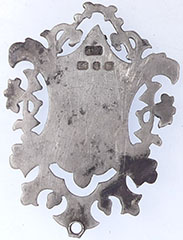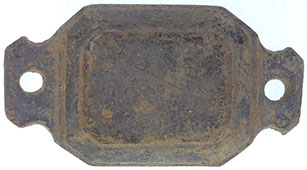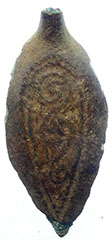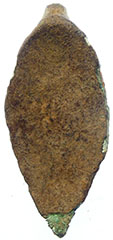

Metal detecting holidays in England with the World's most successful metal detecting club.20 years plus.
Twinned with Midwest Historical Research Society USA.
Mounts all periods
|
A cast copper alloy Medieval or Post-Medieval mount. The mount is basically square but tapers towards to the top to form a triangle with a projecting knop. In profile the knop is slightly bent back. The face of the mount is inscribed with the letters ‘IHS’ within an incised border which flanks the outside edge of the mount. The underside of the mount has three integral rivets in each corner (the fourth being missing) and its edges are upturned. The mount's patina is mid green and there is a trace of blue above the letter H. Most of the object is covered by light green corrosion product and on the reverse the patina is completely covered either by dirt or corrosion product. The mount measures 32.4mm in length, 23.18mm in width and is between 2.13mm and 3.4mm thick (including the upturned edges). It weighs 7.1g. IHS are the first three letters of Jesus. A comparable mount is illustrated in Read, B. Metal Artefacts of Antiquity, Fig 8, no. 88. This is dated to the 15th century and has a different style of lettering and separate rivets. Length 32.31mm, width 23.52mm, max thickness 2.7mm, weight 7.1g. Chronology Broad period: MEDIEVAL Period to: POST MEDIEVAL Date from: Circa AD 1300 Dimensions and weightLength: 32.4 mm Materials and constructionPrimary material: Copper alloy Manufacture method: Cast Completeness: Incomplete
Romano British riveted bronze head mount 36mm L x 24.9mm W x 3.83mm T
Medieval enameled religious belt end- IHS, initials for IESUS HRISTOS SALVATOR, Jesus savior of man - some red and blue enameling remains
|
|||
Medieval cast copper alloy mount. The main body of the mount is triangular, with a projecting arm extending from its shortest edge. The arm has a broken and incomplete semi-circular terminal. The upper surface of the mount has cast decoration in the form of four chevrons. The reverse has an incomplete integrally cast rivet. There is a small amount of gilding surviving on the upper surface. The mount is green-grey in colour, with red-brown showing through on the breaks. It is 18.38mm long, 11.49mm wide, 3.36mm thick and weighs 1.36 grams. ChronologyBroad period: MEDIEVAL Date from: AD 1300 Dimensions and weightLength: 18.38 mm Materials and constructionPrimary material: Copper alloy Manufacture method: Cast Surface Treatment: Gilded
|
|||
16thC Tudor period enamelled mount - Tudor rose at centre of gilded O
Medieval cast copper alloy bar mount. The main body is cirulcar with large central openwork hole. There are two projecting arms extending from opposite sides. Each arm has a circular terminal containing an incomplete copper alloy rivet. The arms have a 'D' shaped cross section. The mount has a green-brown patina. It is 24.55mm long, 8.91mm wide, 4.39mm thick and weighs 2.13 grams. Class: Bar Subsequent actionsSubsequent action after recording: Finder applying for an export licence ChronologyBroad period: MEDIEVAL Date from: AD 1200 Dimensions and weightLength: 24.55 mm Materials and constructionPrimary material: Copper alloy Manufacture method: Cast
|
|||
|
|||
A cast copper alloy bar-mount. The mount has an oblong in the centre with rounded terminals Broad period: MEDIEVAL Date from: AD 1150
|
|||
|
|||
|
|||
A copper-alloy mount in the shape of a bird in flight with wings, tail feathers and neck extended. The junction of the wings with the body is delineated by two shallowly inscribed grooves on each side of the main body. The neck of the bird is bent upwards and the head and the tips of the wings are missing. Two integral mounting spikes remain in place on the underside of the mount, one beneath the body and one beneath the tail of the bird. The forward spike is bent backwards and the point of the rear spike is missing. The mount has a light green patina. It is 32mm long, 20.6mm wide, and 13.4mm thick. It weighs 6.28gm. There are many examples of Roman brooches depicting birds, usually interpreted as ducks, but most depict the bird swimming, not flying. There are also some mounts such as YORYM-CA2DB0 which has a similar attachment mechanism, and LIN-BE4186, which is a similar shaped bird, with an out stretched neck, , but swimming not flying. Examples of Bird in flight brooches include SF-7EEF01, SF-058774, SF-A01500 and WAW-01E006. The mount is Roman in date
ChronologyBroad period: ROMAN Date from: AD 43
|
|||
Roman copper alloy pelta-shaped mount. It is semi-circular, with the upper surface having a concave recess to either side of a projecting rectangular arm with rectangular cross section. There is a break across the top of the arm Broad period: ROMAN Date from: AD 40
|
|||
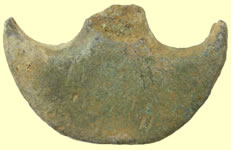  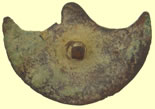 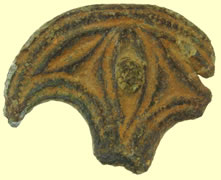 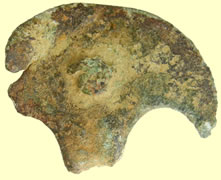 |
|||
Medieval (1250-1500) cast copper alloy bar mount. The mount is rectangular with a raised collar at either end before a circular terminal with a triangular knop. There is a circular rivet hole in each terminal. The mount is bent approximately at two thirds of its length. The metal is red-brown in colour with patches of green corrosion. There are a few very small areas of gilding. In its current bent condition, the mount is 33.17mm long (approximately 50mm long if it were straight) 7.62mm wide across the main body and 7.12mm wide at the terminals. It is 2.56mm thick and weighs 5.44 grams. Class: Bar ChronologyBroad period: MEDIEVAL Dimensions and weightWeight: 5.44 g Materials and constructionPrimary material: Copper alloy Manufacture method: Cast Completeness: Complete |
|||
|
|||
|
|||
Late Medieval to Post medieval (1450-1650AD) cast copper alloy quatrefoil mount; the knops are sub-rectangular, each with a circular rivet hole. The central body is umbonate, with a circular boss at the apex. The metal is dark red-brown, with some gilding surviving on the surface. The reverse is flat and undecorated. It is 34.36mm long, 5.40mm thick and weighs 9.60 grams. ChronologyBroad period: MEDIEVAL Period to: POST MEDIEVAL Date from: AD 1450 Dimensions and weightLength: 34.36 mm Materials and constructionPrimary material: Copper alloy Manufacture method: Cast Surface Treatment: Gilded
|
|||
Incomplete Medieval (1200-1400) cast copper alloy quatrefoil umbonate mount. One of the four arms is missing, and another is incomplete. The two complete arms are sub-rectangular with a curved terminal and central rivet hole, each containing the remains of an iron rivet. The central section of the mount is pyramidal, with each of the four sides having an openwork circle, The apex of the mount is rounded. The reverse of the mount is hollow. The metal is corroded and it is a patchy brown in colour. It is 27.08mm long, 19.13mm wide, 8.32mm deep and weighs 3.97 grams. It is similar to an example in Read (2001) Metal Artefacts of Antiquity, page 13 no 117 (figure 10 no 117). Subsequent actionsSubsequent action after recording: Finder applying for an export licence ChronologyBroad period: MEDIEVAL Date from: AD 1200 Dimensions and weightLength: 27.08 mm Materials and constructionPrimary material: Copper alloy Secondary material: Iron Manufacture method: Cast Completeness: Incomplete |
|||
Shield shaped mount with incised monogram: HL. Dimensions: height 43.9mm, width 38.4mm, thickness 4.4mm, weight 22.28g. ChronologyBroad period: POST MEDIEVAL Period to: POST MEDIEVAL Date from: AD 1540 Dimensions and weightLength: 43.9 mm Materials and constructionPrimary material: Copper alloy Manufacture method: Cast
|
|||
Very unusual zoomophic Saxon mount
Early Medieval gilded mounts with 2 integral lugs
17thC mount
1500-1700 mount
Roman mount
Roman mount
|
|||
|
|
|||
| 1500-1700 mount | |||
|
|||
| 1500-1700 mount |
|||
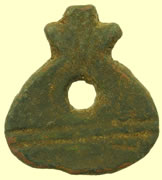 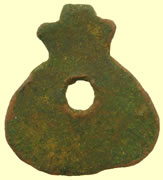 |
|||
| Saxon mount | |||
Victorian silver mount |
|||
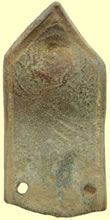 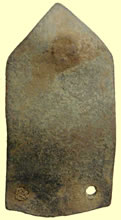 |
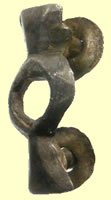 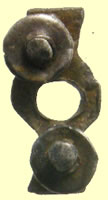 |
  |
|
| Medieval casket mount - King on throne | Medieval silver mount - reported as treasure to museum | ||
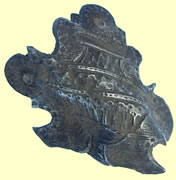 |
  |
||
| Victorian silver mount | Medieval mount | ||
Early medieval gilded mount with circle design |
|||
|
|||
| Early Medieval gilded mounts | |||
|
|||
| Medieval mounts | |||
|
|||
| Large Georgian silver mount | |||
|
|||
| Post medieval Lion headed mount or stud | |||
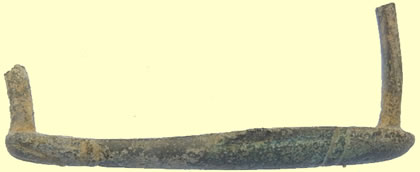  |
|||
| Superb 1500 -1700 fish design belt slide/mount | |||
|
|||
| 1500-1700 mount | |||
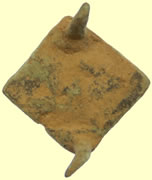 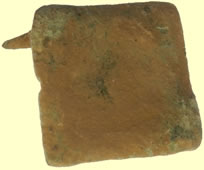 |
|||
| 1500-1700 mount1500-1700 mount | |||
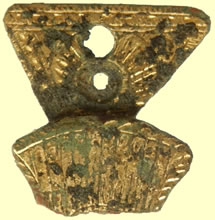 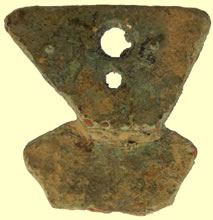 |
|||
| C10thC Saxon gilded mount | |||
1847 Birmingham silver mount - Y date mark
c 8thC Saxon gilded mount - circule design
Medieval heraldic shield mount
John Heath Birmingham mount John Heath established his stationery business in 1852, delivering office products around the Birmingham area and later into other parts of the country.
|
|||
|
|
|||
